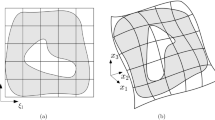Abstract
We propose a discrete weighted Helmholtz decomposition for edge element functions. The decomposition is orthogonal in a weighted \(L^2\) inner product and stable uniformly with respect to the jumps in the discontinuous weight function. As an application, the new Helmholtz decomposition is applied to demonstrate the quasi-optimality of a preconditioned edge element system for solving a saddle-point Maxwell system in non-homogeneous media by a non-overlapping domain decomposition preconditioner, i.e., the condition number grows only as the logarithm of the dimension of the local subproblem associated with an individual subdomain, and more importantly, it is independent of the jumps of the physical coefficients across the interfaces between any two subdomains of different media. Numerical experiments are presented to validate the effectiveness of the non-overlapping domain decomposition preconditioner.

Similar content being viewed by others
References
Alonso, A., Valli, A.: Some remarks on the characterization of the space of tangential traces of \(H({ curl};\Omega )\) and the construction of an extension operator. Manuscr. Math. 89, 159–178 (1996)
Alonso, A., Valli, A.: An optimal domain decomposition preconditioner for low-frequency time-harmonic Maxwell equations. Math. Comp. 68, 607–631 (1999)
Albanese, R., Rubinacci, G.: Magnetostatic field computations in terms of two-component vector potentials. Int. J. Numer. Meth. Eng. 29, 515–532 (1990)
Bramble, J., Pasciak, J., Schatz, A.: The construction of preconditioner for elliptic problems by substructuring. IV. Math. Comp. 53, 1–24 (1989)
Bramble, J., Pasciak, J., Vassilev, A.: Analysis of the inexact Uzawa algorithm for saddle-point problems. SIAM J. Numer. Anal. 34, 1072–1092 (1997)
Bramble, J., Pasciak, J.: A preconditioning technique for indefinite systems resulting from mixed approximations of elliptic problems. Math. Comp. 50, 1–18 (1988)
Brezzi, F., Fortin, M.: Mixed and Hybrid Finite Element Methods. Springer, New York (1991)
Buffa, A., Ciarlet Jr, P.: On traces for functional spaces related to Maxwell’s equations.II. Hodge decompositions on the boundary of Lipschitz polyhedra and applications. Math. Methods Appl. Sci. 24, 31–48 (2001)
Cessenat, M.: Mathematical Methods in Electromagnetism. World Scientific, River Edge (1998)
Ciarlet Jr, P., Zou, J.: Finite element convergence for the Darwin model to Maxwell’s equations. RAIRO Math. Model. Numer. Anal. 31, 213–250 (1997)
Ciarlet Jr, P., Zou, J.: Fully discrete finite element approaches for time-dependent Maxwell’s equations. Numer. Math. 82, 193–219 (1999)
Degond, P., Raviart, P.-A.: An analysis of the Darwin model of approximation to Maxwell’s equations. Forum Math. 4, 13–44 (1992)
Grisvard, P.: Elliptic problems in nonsmooth domains. In: Monographs and Studies in Mathematics, vol. 24. Pitman, London (1985)
Hiptmair, R.: Multigrid method for Maxwell’s equations. SIAM J. Numer. Anal. 36, 204–225 (1998)
Hiptmair, R.: Finite elements in computational electromagnetism. Acta Numer. 11, 237–339 (2002)
Hu, Q.: Preconditioning Poincare–Steklov operators arising from domain decompositions with mortar multipliers. IMA J. Numer. Anal. 24, 643–669 (2004)
Hu, Q., Liang, G., Lui, J.: Construction of a preconditioner for domain decomposition methods with polynomial multipliers. J. Comput. Math. 19, 213–224 (2001)
Hu, Q., Zou, J.: An iterative method with variable relaxation parameters for saddle-point problems. SIAM J. Matrix Anal. Appl. 23, 317–338 (2001)
Hu, Q., Zou, J.: Two new variants of nonlinear inexact Uzawa algorithms for saddle-point problems. Numer. Math. 93, 333–359 (2002)
Hu, Q., Zou, J.: A nonoverlapping domain decomposition method for Maxwell’s equations in three dimensions. SIAM J. Numer. Anal. 41, 1682–1708 (2003)
Hu, Q., Zou, J.: Substructuring preconditioners for saddle-point problems arising from Maxwell’s equations in three dimensions. Math. Comput. 73, 35–61 (2004)
Hu, Q., Zou, J.: A weighted Helmholtz decomposition and applications to domain decomposition for saddle-point Maxwell systems. Technical Report 2007–15 (355), Department of Mathematics, The Chinese University of Hong Kong
Dautray, R., Lions, J.-L.: Mathematical Analysis and Numerical Methods for Science and Technology. Springer, New York (1992)
Klawonn, A., Widlund, O., Dryja, M.: Dual-primal FETI methods for three-dimensional elliptic problems with heterogeneous coefficients. SIAM J. Numer. Anal. 40, 159–179 (2002)
Monk, P.: Finite Element Methods for Maxwell’s Equations. Oxford University Press, Oxford (2003)
Rusten, T., Winther, R.: A preconditioned iterative method for saddlepoint problems. SIAM J. Matrix Anal. Appl. 13, 887–904 (1992)
Saranen, J.: On electric and magnetic problems for vector fields in anisotropic nonhomogeneous media. J. Math. Anal. Appl. 91, 254–275 (1983)
Toselli, A.: Overlapping Schwarz methods for Maxwell’s equations in three dimensions. Numer. Math. 86, 733–752 (2000)
Toselli, A.: Dual-primal FETI algorithms for edge element approximations: three-dimensional h finite elements on shape-regular meshes. IMA J. Numer. Anal. 26, 96–130 (2006)
Toselli, A., Widlund, O.: Domain Decomposition Methods—Algorithms and Theory, vol. 34. In: Springer Series in Computational Mathematics. Springer, Berlin (2005)
Toselli, A., Widlund, O., Wohlmuth, B.: An iterative substructuring method for Maxwell’s equations in two dimensions. Math. Comp. 70, 935–949 (2001)
Xu, J., Zou, J.: Some nonoverlapping domain decomposition methods. SIAM Rev. 40, 857–914 (1998)
Acknowledgments
The authors wish to thank the anonymous referee for many constructive and insightful comments which have led to a great improvement of the results and organization of the paper, and also thank Dr. Junxian Wang and Dr. Chunsheng Feng from Xiangtan University for their help with the numerical experiments.
Author information
Authors and Affiliations
Corresponding author
Additional information
The work of Q. Hu was supported by the Major Research Plan of Natural Science Foundation of China G91130015, the Key Project of Natural Science Foundation of China G11031006 and National Basic Research Program of China G2011309702. The work of S. Shu was supported by NSFC Projects G91130002 and G11171281, the Project of Scientific Research Fund of Hunan Provincial Education Department (12A138) and the Program for Changjiang Scholars and Innovative Research Team in University of China (No. IRT1179). The work of J. Zou was substantially supported by Hong Kong RGC grant (Project 405110) and CUHK Focused Investment Scheme 2012/2014.
Rights and permissions
About this article
Cite this article
Hu, Q., Shu, S. & Zou, J. A discrete weighted Helmholtz decomposition and its application. Numer. Math. 125, 153–189 (2013). https://doi.org/10.1007/s00211-013-0536-6
Received:
Revised:
Published:
Issue Date:
DOI: https://doi.org/10.1007/s00211-013-0536-6




